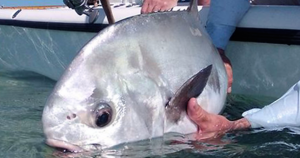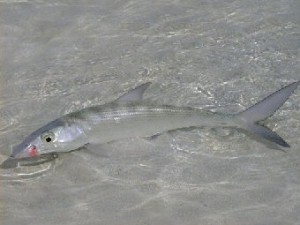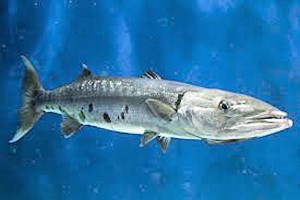Angling teams can vie for awards while targeting the Lower Florida Keys’ wiliest species during the rescheduled Sugarloaf Showdown, a fundraising fishing tournament scheduled Thursday through Saturday, Jan. 28-30.
Presented by the Lower Keys Guides Association, the seventh annual tournament was originally slated for November 2020 but was postponed because of inclement weather. It raises money for the Florida Keys Guides Trust Foundation, which provides funds to assist fishing guides who are recovering from an illness or injury.
Participants must use either spin or fly tackle to pursue the catch-and-release tournament’s target species of permit, bonefish and barracuda.
Participants must use either spin or fly tackle to pursue the catch-and-release tournament’s target species of permit, bonefish and barracuda. A kids division is featured for young anglers under age 12.
A maximum of three fish of each species can be scored per team per day.
Awards await the three teams in both fly and spin divisions with the highest total points that represent catches of all three species. If no team catches all three, the team with the highest point total representing two species will be declared the winner.
Other prizes include awards to the high-point participants in each target species.
According to organizers, tournament entrants are to follow Monroe County coronavirus health safety protocols throughout, including wearing facial coverings and social distancing.

Anglers meet and depart from Sugarloaf Marina.
Final registration and check-in for the Showdown are slated for 4-7 p.m. Thursday, Jan. 28, at the Sugarloaf Marina, located at 17015 Overseas Highway adjacent to the Sugarloaf Lodge. Anglers can pick up their tournament bags and rules and bid on quality gear at a silent auction that continues through Jan. 30.
Fishing is scheduled to begin with a mandatory 6:30 a.m. check-in with the scorekeeper Friday and Saturday, with angling scheduled from 7:30 a.m. to 4 p.m. All boats must be back and teams checked in with the scorekeeper by 5:30 p.m. each evening.
The entry fee is $250 for a two-person team or a team consisting of two anglers plus a guide. Competition is open to all anglers and guides, but only two people on each team are allowed to fish.
Event information and registration: sugarloafshowdown.com
Source: Lower Keys’ Sugarloaf Showdown to Target Three Wily Species Jan. 28-30
Permit
Appearance
- Gray, dark or iridescent blue back, shading to silver sides
- Fish from dark waters have golden tints on belly
- Dorsal fin begins over anal fin
- Dorsal, anal and caudal fins long and sloped back
- Forehead sharply rises to a “hump” then slopes back
- Compressed body that is deeper than Florida pompano
- Caudal fin has a narrow fork
- Small permit have teeth on their tongue (absent in pompano)
Similar Species: Florida pompano, T. carolinus (dorsal fin begins in front of anal fin)
Size: Common to 50 pounds
Offshore near structure; inshore over grass flats, sand and in channels.
Spawning occurs primarily in early summer and again in fall.
Permit have a specialized plate at the back of their mouth that helps them crush hard-shelled animals such as clams and crabs. Feeds on small fishes and invertebrates.
State Record: 56 lb 2 oz, caught near Ft. Lauderdale
Fishing Tips and Facts: Anglers cast live crabs to schools of permit hoping to catch one of these line-stripping fish, which also take shrimp, clams and occasionally small fish.
Bonefish
Bonefish is a Catch-And-Release fishery
June 2013: FWC Commissioners approved measures to make bonefish a catch-and-release only fishery. This includes the elimination of a tournament exemption permit. This exemption allowed tournament anglers with the proper permit to temporarily possess bonefish for transport to a tournament scale. This change went into effect Sept. 1, 2013. The use of a multiple hook in conjunction with live or dead natural bait to harvest or attempt to harvest bonefish was also prohibited Sept. 1, 2013.
Biology of the “Grey Ghosts”
Bonefish are one of Florida’s premier gamefish and are known as “grey ghosts of the flats” because they are stealthy, fast-swimming fish that are exciting and challenging to catch. South Florida is one of the few places in the United States where anglers have the unique opportunity to fish for bonefish and the shallow saltwater flats of the Florida Keys and Biscayne Bay are considered a world-class destination for catching large, trophy-sized bonefish.
Bonefish mature at three to four years of age (17-18 inches total length), may live longer than 23 years, and grow to be three feet long and 15 pounds. Bonefish can be caught year-round in the Keys, but peak bonefish season is generally March through October. Not much is known about the biology of bonefish, but spawning occurs from November through May, probably in deep water or offshore.
There are multiple similar-looking species of bonefish that inhabit Florida waters, but the common bonefish (Albula vulpes) dominates Florida’s recreational fishery. Little is known about the other bonefish species, but many juvenile bonefish caught in Florida have been identified as bigeye bonefish (Albula garcia). Bigeye bonefish appear to live in Florida waters as juveniles and leave sometime before adulthood.
Conserving One of Florida’s Most Valuable Gamefish
A recent study by scientists at the University of Miami estimated the value of a single bonefish in the Florida Keys to be $3,500 each year. That’s nearly $75,000 over the lifespan of the fish! Most bonefish anglers recognize the value of bonefish as a gamefish in Florida and practice catch and release with the bonefish they catch. Visit the links below to learn about catch and release and proper fish handling practices you can use on your next fishing trip to help conserve bonefish.
Barracuda
Appearance
- Gray with a greenish color on the back, shading to a lighter belly
- Mouth with prominent, sharp teeth; lower jaw protrudes past upper jaw
- Black blotches on lower sides
- Diagonal dark bars on upper sides (not always evident)
- Tail color is dark with white tips
- Young have dark stripe on side that breaks into dark blotches with age
Size: Up to 106 pounds
Habitat
Range inshore to offshore. Young found inshore in seagrass beds.
Behavior
Top predator in reef areas, consuming fishes, squid and shrimp.
Additional Information
Consuming larger barracuda may cause ciguatera poisoning.



